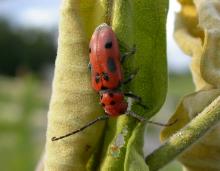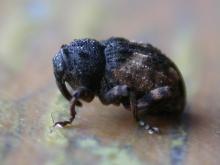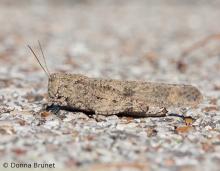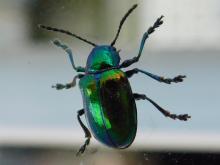Land Invertebrates
Media

Species Types
Scientific Name
About 1,000 species in North America north of Mexico
Description
Longhorned beetles are elongated and cylindrical, with antennae that are at least half the length of the body — sometimes much longer. The larvae are grubs that bore in wood or other plants. Some are serious pests.
Media

Species Types
Scientific Name
About 2,500 species in North America north of Mexico
Description
Weevils are plant-eating beetles with a characteristic long, down-curving snout. The antennae are clubbed and elbowed. There are thousands of weevil species.
Media

Species Types
Scientific Name
About 60 species in North America north of Mexico
Description
The nymphs of spittlebugs and froghoppers are famous for hiding in small foamy masses of fluid. The “spit” conceals them as they suck juices from plant stems. The adults resemble leafhoppers.
Media

Species Types
Scientific Name
Scudderia furcata
Description
The fork-tailed bush katydid reaches about 1¾ inches long. It is usually leafy green and is most common in bushes, thickets, and other shrubby areas. It is most active after dusk. The call is a simple "tsip!" given every few seconds.
Media

Species Types
Scientific Name
About 1,300 species in North America north of Mexico
Description
The longlegged flies are a large, diverse fly family. They often have eye-catching metallic green, copper, bronze, or blue bodies and long legs. Their delicate wings are often clear and look iridescent in bright light, but many species have dark marks near the wing tips.
Media

Species Types
Scientific Name
Dissosteira carolina
Description
The Carolina grasshopper is frequently seen in dusty, open habitats like dirt roads and vacant lots. Its yellow-bordered, black hindwings make it look like a mourning cloak butterfly.
Media

Species Types
Scientific Name
Chrysochus auratus
Description
The shiny, iridescent dogbane beetle is one of Missouri's most beautiful insects. As the name indicates, this beautiful beetle feeds on dogbanes.
Media

Species Types
Scientific Name
Phanaeus vindex
Description
Although most dung beetles are dull black, the rainbow scarab is bright metallic green and copper.
Media

Species Types
Scientific Name
About 2,000 species in North America north of Mexico
Description
Plant bugs, or mirids, are a huge family of true bugs. They are often overlooked — except by gardeners and farmers. Most mirids eat plants, and some are agricultural pests. As a group, they’re an important food source for birds and other insectivores.
Media

Species Types
Scientific Name
Schistocerca spp.
Description
About six species of bird grasshoppers occur in Missouri. Most are attractively marked, large insects that gracefully fly from danger, almost like birds.
See Also



Media

Species Types
Scientific Name
Cisseps fulvicollis
Description
The yellow-collared scape moth is more often “orange-collared.” And whether you think it looks more like a firefly or a wasp, it’s still a moth!
Media

Species Types
Scientific Name
Nearly 150 species in North America north of Mexico
Description
Slim, delicate plume moths are instantly recognizable by their T-shaped silhouette, long legs, and muted shades of tan and brown. It can be hard to separate the various species.
Media

Species Types
Scientific Name
Pyrrharctia isabella
Description
Not many people know the adult Isabella tiger moth when they see one, but we’re all acquainted with its caterpillar, the woolly worm, or woolly bear.
About Land Invertebrates in Missouri
Invertebrates are animals without backbones, including earthworms, slugs, snails, and arthropods. Arthropods—invertebrates with “jointed legs” — are a group of invertebrates that includes crayfish, shrimp, millipedes, centipedes, mites, spiders, and insects. There may be as many as 10 million species of insects alive on earth today, and they probably constitute more than 90 percent all animal species.





















